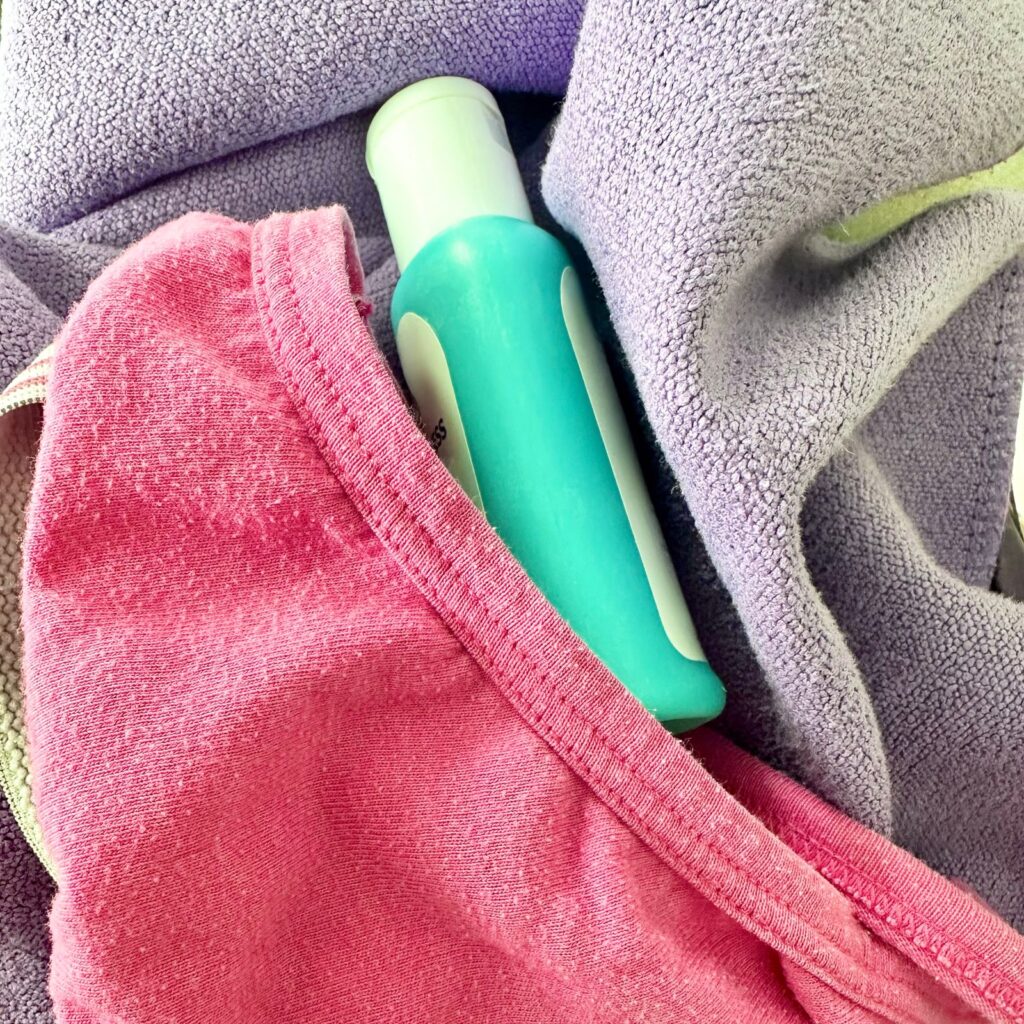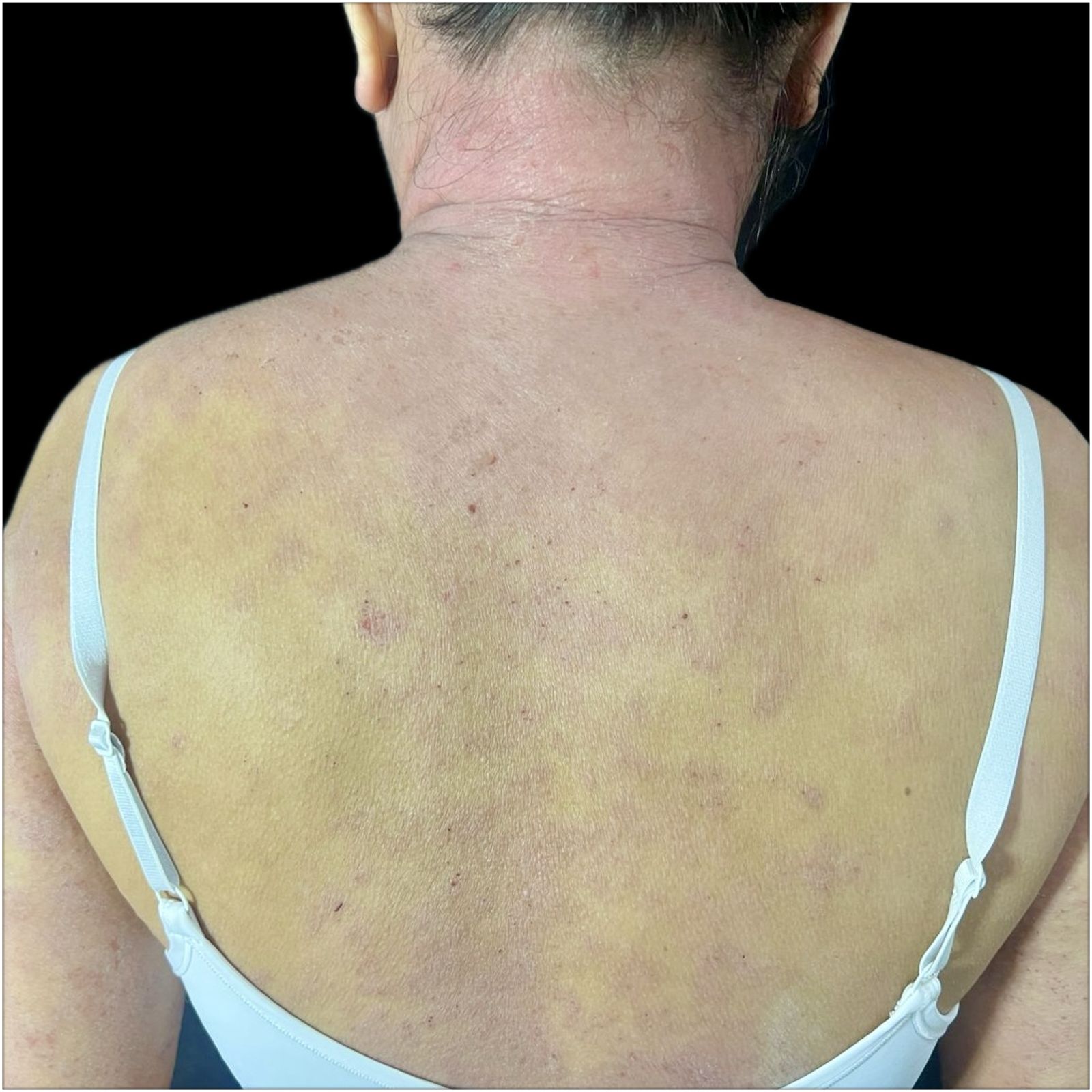Allergen
Feminine Washes and Wipes
Vaginal washes, douches, and wipes tend to be marketed to imply that there is something wrong about a woman’s vulva and vagina (there isn’t). These products therefore usually contain ingredients meant to mask or “correct” the area’s natural, inherent odor (lots of fragrance) or perceived uncleanliness (antibacterial ingredients). Besides being top contact allergens, these ingredients can cause yeast infection, bacterial vaginosis, and other problems. More on caring for the area below.
Other top contact allergens that are common in feminine washes and wipes — and that can cause itching, pain, discomfort, allergic and irritant reactions — include:
- Fragrance and perfumes (so allergenic, and so prevalent in these products, that they’re worth repeating!) and related ingredients like benzyl alcohol
- Allergen amidoamine surfactants like cocamidopropyl betaine and cocamide-dea
- Fruit and flower extracts; other allergenic natural extracts like lavender, chamomile, citruses, citronellol, geraniol, limonene, linalool, mint, cinnamon, tea tree oil, camphor
- Phenoxyethanol, quaternium, parabens, and other allergen preservatives
- Dyes
- Tocopheryl acetate (vitamin E)
- Propylene glycol
- Acrylates (less of a problem when hardened; their presence in liquid formulations that are not intended to harden could be more of a concern)
- Isothiazolinone and definitely watch for methylchloroisothiazolinone/methylisothiazolinone or MCI/MI in wipes
NOTE: some feminine hygiene products market themselves as “natural.” Many natural substances are proven contact allergens, enough so that a recent study in the Journal of Drugs in Dermatology states, “We emphasize the misconception of clean, natural, organic, and vegan to equal safe.” The same study notes that “Many naturally derived ingredients are the cause of dermatitis.” Opt for validated hypoallergenic and use your patch test results to guide you.
Antiseptic or antimicrobial products may contain allergenic antibacterials or seriously disrupt the balance of the flora (the healthy microbiome) of the area, leading to yeast or other infections.
Products with active lightening ingredients could also be too irritating for this delicate area. Darkening around the genitals is often due to exposure to top contact allergens or pigmented contact dermatitis. Simply switching to allergen-free options (see below) can go a long way towards effective and safe lightening.
Vaginas are self cleansing:
Gynecologists generally discourage the use of feminine washes and douches due to the risk of their disrupting the natural vaginal flora, causing an imbalance in the pH of the area, or leading to an infection.
The vulva (labia, clitoris, clitoral hood) can use gentle cleansing but the vagina (the internal canal) is self cleansing.
The vagina is self cleaning and the vulva only really needs water for cleansing. If you would like more cleansing:
- Choose a mild liquid body wash that’s fragrance-free, dye-free, paraben-free, preservative-free, allergen surfactant-free, and allergen-free like Clark Wash or Superwash.
- You could also use virgin coconut oil (just be careful when using latex condoms as oils can degrade the material).
- Some research suggests that virgin coconut oil can also provide relief as effective as some ECT (estrogen containing therapies) vaginal dryness and dyspareunia (VDD) and without adverse reactions. This one study included pre and postmenopausal women with VDD, with and without Rheumatic Autoimmune Diseases such as primary Sjogren’s syndrome, where VDD is a common symptom. Ask your gynecologist and dermatologist.
- Avoid douching.
The vagina has a natural odor, and it can vary from person to person and it can also change depending on your menstrual cycle or diet. Despite what these products might imply, no vagina is supposed to smell like a rose garden.
If you notice a very unpleasant or pungent smell and/or discharge that’s thick, yellow, gray or green (clear and white is usually normal, as is reddish-brown around your period), pain, or other abnormal symptoms, consult your ob-gyn.
Other care:
- If you’re interested in a whole-body deo, choose one that’s allergen-free like Stay Fresh-ener. Do not spray directly onto the vulva (and certainly not into the vagina) — apply on the buttocks, backs of the thighs, inner thighs, etc. (external skin).
- Launder your underwear with allergen-free products like Superwash.
- Choose menstrual sanitary pads with less contact allergens (some tips here). Do not leave tampons in for longer than the specified time. Consider safer toilet paper materials, too.
- Choose cotton underwear — non-stretchy, unchlorinated, unbleached, uncolored, pure organic cotton would be best. Cottonique has options. Avoid nylon and other synthetic materials, which can trap in heat and moisture.
- Don’t stay in sweaty or wet clothes. After swimming or working out, change quickly into dry clothes to prevent infections.
- Speak to your healthcare provider about safer sex practices to protect yourself from STIs (sexually transmitted infections). Learn more about other skin issues related to the genital areas here.
Subscribe to VMVinSKIN.com and our YouTube channel for more hypoallergenic tips and helpful “skinformation”!
If you have a history of sensitive skin…
…don’t guess! Random trial and error can cause more damage. Ask your dermatologist about a patch test.
To shop our selection of hypoallergenic products, visit vmvhypoallergenics.com. Need help? Ask us in the comments section below, or for more privacy (such as when asking us to customize recommendations for you based on your patch test results) contact us by email, or drop us a private message on Facebook.
For more:
- On the prevalence of skin allergies, see Skin Allergies Are More Common Than Ever.
- For the difference between irritant and allergic reactions, see It’s Complicated: Allergic Versus Irritant Reaction.
- For the difference between food, skin, and other types of reactions: see Skin & Food Allergies Are Not The Same Thing.
- On the differences between hypoallergenic, natural, and organic, check out Is Natural Hypoallergenic? and this video in our YouTube channel.
- To learn about the VH-Rating System and hypoallergenicity: What Is The Validated Hypoallergenic Rating System?
Main References:
Regularly published reports on the most common allergens by the North American Contact Dermatitis Group and European Surveillance System on Contact Allergies (based on over 28,000 patch test results, combined), plus other studies. Remember, we are all individuals — just because an ingredient is not on the most common allergen lists does not mean you cannot be sensitive to it, or that it will not become an allergen. These references, being based on so many patch test results, are a good basis but it is always best to get a patch test yourself.
- Graziottin A. Maintaining vulvar, vaginal and perineal health: Clinical considerations. Womens Health (Lond). 2024 Jan-Dec;20:17455057231223716.
- Cleveland Clinic. (2023, November 9). Vulva. https://my.clevelandclinic.org/health/body/vulva#care. Accessed April 12, 2025.
- Albornoz MA, Burke JF, Threlfall EK. Virgin Coconut Oil in Paste Form as Treatment for Dyspareunia and Vaginal Dryness in Patients With and Without Rheumatic Autoimmune Diseases: An Efficacy and Safety Assessment Pilot Study. Cureus. 2023 Jun 16;15(6):e40501.
- Urban K, Giesey R, Delost G. A Guide to Informed Skincare: The Meaning of Clean, Natural, Organic, Vegan, and Cruelty-Free. J Drugs Dermatol. 2022 Sep 1;21(9):1012-1013.
- DeKoven JG, Warshaw EM, Reeder MJ, Atwater AR, Silverberg JI, Belsito DV, Sasseville D, Zug KA, Taylor JS, Pratt MD, Maibach HI, Fowler JF Jr, Adler BL, Houle MC, Mowad CM, Botto N, Yu J, Dunnick CA. North American Contact Dermatitis Group Patch Test Results: 2019-2020. Dermatitis. 2023 Mar-Apr;34(2):90-104. doi: 10.1089/derm.2022.29017.jdk. Epub 2023 Jan 19. PMID: 36917520.
- Uter W, Wilkinson SM, Aerts O, Bauer A, Borrego L, Brans R, Buhl T, Dickel H, Dugonik A, Filon FL, Garcìa PM, Giménez-Arnau A, Patruno C, Pesonen M, Pónyai G, Rustemeyer T, Schubert S, Schuttelaar MA, Simon D, Stingeni L, Valiukevičienė S, Weisshaar E, Werfel T, Gonçalo M; ESSCA and EBS ESCD working groups, and the GEIDAC. Patch test results with the European baseline series, 2019/20-Joint European results of the ESSCA and the EBS working groups of the ESCD, and the GEIDAC. Contact Dermatitis. 2022 Oct;87(4):343-355. doi: 10.1111/cod.14170. Epub 2022 Jun 24. PMID: 35678309. https://pubmed.ncbi.nlm.nih.gov/35678309/
- DeKoven JG, Silverberg JI, Warshaw EM, Atwater AR, et al. North American Contact Dermatitis Group Patch Test Results: 2017-2018. Dermatitis. 2021 Mar-Apr 01;32(2):111-123.
- DeKoven JG, Warshaw EM, Zug KA, et al. North American Contact Dermatitis Group Patch Test Results: 2015-2016. Dermatitis. 2018 Nov/Dec;29(6):297-309.
- DeKoven JG, Warshaw EM, Belsito DV, et al. North American Contact Dermatitis Group Patch Test Results 2013-2014. Dermatitis. 2017 Jan/Feb;28(1):33-46.
- Warshaw, E.M., Maibach, H.I., Taylor, J.S., et al. North American contact dermatitis group patch test results: 2011-2012. Dermatitis. 2015; 26: 49-59.
- W Uter et al. The European Baseline Series in 10 European Countries, 2005/2006–Results of the European Surveillance System on Contact Allergies (ESSCA). Contact Dermatitis 61 (1), 31-38.7 2009.
- Wetter, DA et al. Results of patch testing to personal care product allergens in a standard series and a supplemental cosmetic series: An analysis of 945 patients from the Mayo Clinic Contact Dermatitis Group, 2000-2007. J Am Acad Dermatol. 2010 Nov;63(5):789-98.
- Warshaw EM, Buonomo M, DeKoven JG, et al. Importance of Supplemental Patch Testing Beyond a Screening Series for Patients With Dermatitis: The North American Contact Dermatitis Group Experience. JAMA Dermatol. 2021 Dec 1;157(12):1456-1465.
- Verallo-Rowell VM. The validated hypoallergenic cosmetics rating system: its 30-year evolution and effect on the prevalence of cosmetic reactions. Dermatitis 2011 Apr; 22(2):80-97.
- Ruby Pawankar et al. World Health Organization. White Book on Allergy 2011-2012 Executive Summary.
- Misery L et al. Sensitive skin in the American population: prevalence, clinical data, and role of the dermatologist. Int J Dermatol. 2011 Aug;50(8):961-7.
- Warshaw EM1, Maibach HI, Taylor JS, Sasseville D, DeKoven JG, Zirwas MJ, Fransway AF, Mathias CG, Zug KA, DeLeo VA, Fowler JF Jr, Marks JG, Pratt MD, Storrs FJ, Belsito DV. North American contact dermatitis group patch test results: 2011-2012.Dermatitis. 2015 Jan-Feb;26(1):49-59.
- Warshaw, E et al. Allergic patch test reactions associated with cosmetics: Retrospective analysis of cross-sectional data from the North American Contact Dermatitis Group, 2001-2004. J AmAcadDermatol 2009;60:23-38.
- Marks JG, Belsito DV, DeLeo VA, et al. North American Contact Dermatitis Group patch-test results, 1998 to 2000. Am J Contact Dermat. 2003;14(2):59-62.
- Warshaw EM, Belsito DV, Taylor JS, et al. North American Contact Dermatitis Group patch test results: 2009 to 2010. Dermatitis. 2013;24(2):50-99.
- Verallo-Rowell V. M, Katalbas S.S. & Pangasinan J. P. Natural (Mineral, Vegetable, Coconut, Essential) Oils and Contact Dermatitis. Curr Allergy Asthma Rep 16,51 (2016) . https://doi.org/10.1007/s11882-016-0630-9.
- de Groot AC. Monographs in Contact Allergy, Volume II – Fragrances and Essential Oils. Boca Raton, FL: CRC Press Taylor & Francis Group; 2019.
- De Groot AC. Monographs in Contact Allergy Volume I. Non-Fragrance Allergens in Cosmetics (Part I and Part 2). Boca Raton, Fl, USA: CRC Press Taylor and Francis Group, 2018.
- Zhu TH, Suresh R, Warshaw E, et al. The Medical Necessity of Comprehensive Patch Testing. Dermatitis. 2018 May/Jun;29(3):107-111.
Want more great information on contact dermatitis? Check out the American Contact Dermatitis Society, Dermnet New Zealand, the Contact Dermatitis Institute, and your country’s contact dermatitis association.

Laura is our “dew”-good CEO at VMV Hypoallergenics and eldest daughter of VMV’s founding dermatologist-dermatopathologist. She has two children, Madison and Gavin, and works at VMV with her family and VMV’s signature “skinfatuated, skintellectual, skingenious” team. In addition to saving the world’s skin, Laura is passionate about health, cultural theory, human rights, happiness, and spreading goodness (like a VMV cream)!







